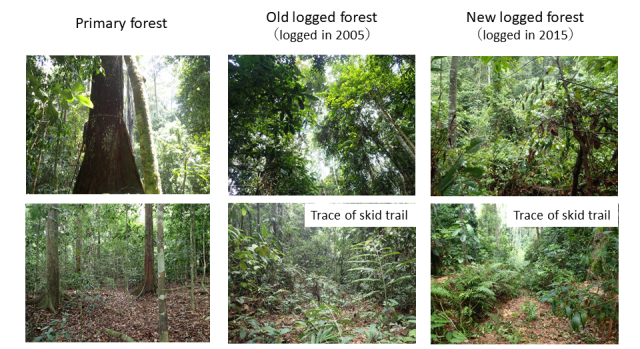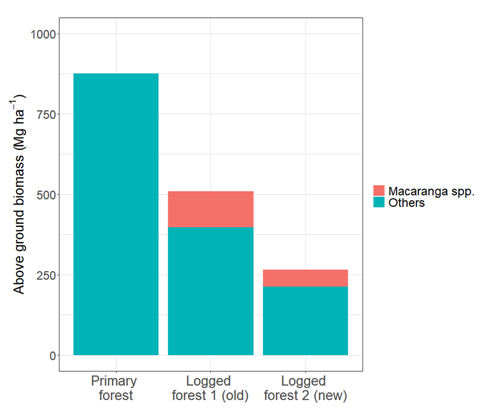Home > International Partnerships > Collaborative Research > Effects of Different Logging Impacts on the Recovery of Fine Root Biomass in Tropical Forests in Borneo
Update:June 22, 2023
Main content starts here.
Effects of Different Logging Impacts on the Recovery of Fine Root Biomass in Tropical Forests in Borneo
 |
|
Photographs show the primary forest, the old selective logging forest that was logged in 2005, and the new selective logging forest that was logged in 2015. In the primary forest, emergent trees of the Dipterocarpaceae family are present, while in the two selective logging forests, Macaranga species that prefers disturbed sites is dominant. In addition, shrubs have established themselves on the remains of the skid trail used during logging, and the trail is gradually becoming indistinguishable.
|
1. Partners
Forest Research Centre, Sabah Forestry Department, Malaysia
2. Research Period
FY 2018-2022 Grant-in-Aid for Scientific Research (KAKENHI)
3. Lead Researcher
MIYAMOTO, Kazuki
4. Background
In some tropical production forests, reduced-impact logging (RIL) is implemented as a practical method for ensuring sustainable forest management following the previously unregulated logging history. However, while the effect of logging on the aboveground parts of trees growing in tropical forests has been investigated, little is still known about its effect on recovery of the belowground biomass. The fine roots of trees (defined here as tree roots ≤2 mm in diameter) play a fundamental role in the absorption of water and soil nutrients and can also contribute to the belowground carbon dynamics through their continual production and death. Therefore, consideration of the recovery of the fine root biomass is important for understanding the effects of logging on the belowground biomass in tropical forests.
5. Research Goal
This research project will compare primary and logged forests in Borneo with different logging histories (old and new selective logging forests) to determine the effects and factors of different logging histories on the recovery of above- and below-ground fine root biomass in tropical forests.
6. Research Strategy
To determine the effects of different logging histories on the recovery of aboveground and fine-root biomass in lowland tropical forests in Borneo, we examined the following items in a design comparing primary tropical forests and selectively logged forests with different logging histories in the Maliau Basin Conservation Area and its surrounding areas in Sabah, Malaysia:
1) Degree of above-ground disturbance and recovery: tree size distribution, tree dynamics (growth and mortality), and above-ground biomass, and
2) Recovery of fine roots: biomass and production rate of fine roots (roots <2 mm in diameter).
The study sites were selected where logging took place in 2005 and 2015 on the periphery of the protected area.
7. Scientific Achievement
Above-ground biomass was higher in the order of primary forest > old logged forest > new logged forest (Figure 1). In the new logged forest, the overall trunk diameter growth rate was higher than in the other forests, especially that of the recently invaded and established pioneer species (trees that invade and establish in open areas by falling trees or logging) of the genus Macaranga. On the other hand, the old logged and primary forests showed a lower diameter growth rates compared to the new logged forest. Tree mortality rate was higher in the two logged forests compared to the primary forest. In terms of smaller-sized Macaranga trees (trunk diameter <15 cm), the old logged forest tended to have fewer small diameter trees and higher mortality rate than the new logged forest, suggesting that regeneration was not progressing well.
In most cases, no statistical differences in fine root biomass were found between forests due to high site-to-site variability, but the new logged forest showed a tendency for fine root biomass to be lower in the skid trail used during logging than in understory of the primary forest. In addition, there was no difference in fine root production between forests.
These results indicate that the old logged forests have characteristics close to those of the primary forest, and that forest recovery is relatively progressing in the old logged forest compared to the new logged forests. In the old logged forests, the establishment of the pioneer species, Macaranga, has settled down and is expected to be replaced by other tree species in the future.
 |
|
This bar graph compares above ground biomass among the primary forest and old and new logged forests. The above ground biomass was 875 Mg/ha in the primary forest, 510 Mg/ha in the old logged forest, and 265 Mg/ha in the new logged forest. Macaranga species also contribute to above ground biomass of the two logged forests.
|
8. Applications
The results of this research are expected to contribute to the understanding of the recovery process of tropical forests from logging activities. The results obtained from this research project will be shared with the Sabah Forestry Department, our collaborating institution, to contribute to the Department's goal of sustainable forest management.
9. Publications
MIYAMOTO Kazuki, AIBA Shin-ichiro, AOYAGI Ryota, Reuben Nilus. Impact of logging on species composition and fine-root biomass in tropical forests in Borneo. Abstract of Annual Meeting of the Ecological Society Japan 67:P2-PC-204. March 2020 [In Japanese].
MIYAMOTO Kazuki, AIBA Shin-ichiro, AOYAGI Ryota, Reuben Nilus. Comparison of forest structure and species composition in primary and logged forests in Borneo. Abstract of Annual Meeting of the Ecological Society Japan 68:P2-124. March 2021 [In Japanese].
MIYAMOTO Kazuki, AIBA Shin-ichiro, AOYAGI Ryota, Reuben Nilus. Distribution characteristics of pioneer tree species in selectively logged forests in Borneo. Abstract of Annual Meeting of the Japan Society of Tropical Ecology 31:A17. June 2021 [In Japanese].
MIYAMOTO Kazuki, AIBA Shin-ichiro, AOYAGI Ryota, Reuben Nilus. Distribution characteristics of pioneer tree species in selectively logged forests in Borneo. Abstract of Annual Meeting of the Ecological Society Japan 70:P2-081. March 2023 [In Japanese].
Copyright © Forest Research and Management Organization. All rights reserved.
